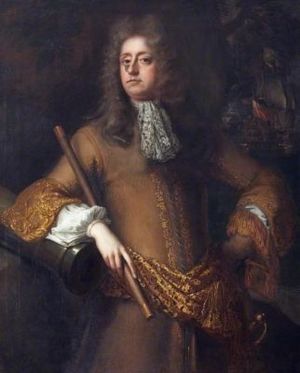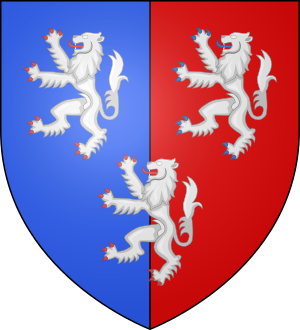Arthur Herbert, 1st Earl of Torrington facts for kids
Quick facts for kids
The Earl of Torrington
|
|
|---|---|

Arthur Herbert, 1st Earl of Torrington, portrait by John Closterman
|
|
| Born | c.1648 |
| Died | 13 April 1716 (aged 67–68) |
| Buried | |
| Allegiance | |
| Service/ |
|
| Years of service | 1663–1690 |
| Rank | Admiral |
| Commands held | HMS Pembroke HMS Constant Warwick HMS Dragon HMS Dreadnought HMS Cambridge HMS Rupert |
| Battles/wars | Second Anglo-Dutch War Franco-Dutch War Nine Years' War |
Arthur Herbert, 1st Earl of Torrington (born around 1648 – died 13 April 1716) was an important officer in the Royal Navy. He was also a nobleman and a politician. King James II of England fired him in 1688. This happened because Herbert refused to vote to change a law called the Test Act. This law stopped Roman Catholics from holding public jobs.
After being fired, Herbert secretly carried an important message to William of Orange in Holland. He was disguised as a simple sailor. As a reward, William made him the commander of his invasion fleet. This fleet landed in England on 5 November 1688. This event started the Glorious Revolution, which changed who ruled England.
Arthur Herbert was born around 1648. His father was Sir Edward Herbert. Arthur joined the Royal Navy in 1663 when he was about 15 years old.
He became a lieutenant on HMS Defiance. He fought in the St. James's Day Battle in July 1666. This was during the Second Anglo-Dutch War.
In 1666, he was promoted to post-captain. He commanded several ships, including:
- HMS Pembroke (starting April 1667)
- HMS Constant Warwick (starting September 1668)
- HMS Dragon (starting May 1672)
He also commanded HMS Dreadnought in 1672. He led this ship at the Battle of Solebay in May 1672. This battle was part of the Franco-Dutch War. Later, he took command of HMS Cambridge in October 1673. He was badly hurt while leading this ship at the Battle of Schooneveld in June 1673.
In 1678, he took command of HMS Rupert. In 1679, he led a group of ships. Their job was to protect Tangier from attacks.
Becoming a Flag Officer
In 1683, Herbert was made Rear-admiral of England. This was a very high rank in the navy. In 1685, he also became the Master of the Robes. This job involved managing the King's clothes and personal items. These jobs paid him a lot of money.
However, King James II asked Herbert to promise something. The King wanted him to vote to get rid of the Test Act. This law stopped Roman Catholics from holding public jobs. Herbert refused, saying it went against his honor and conscience. The King was very angry and fired him from all his jobs.
In June 1688, Herbert went to Holland. He carried a secret message called the Invitation to William. He offered his help to William of Orange. William then made Herbert the main commander of the fleet. This fleet would take William to England.
After the Glorious Revolution, Herbert received many honors. He became Lord High Admiral. Later, he became the First Lord of the Admiralty. This meant he was in charge of the entire navy. In May 1689, King William III made him a nobleman. He became the Earl of Torrington and Baron Herbert of Torbay. This happened after he commanded the English ships at the Battle of Bantry Bay.
Herbert is famous for using the idea of a "fleet in being". This means keeping your navy strong and ready. Even if you don't fight a big battle, your strong navy forces the enemy to stay nearby. This stops them from doing other things.
In July 1690, Herbert commanded the English and Dutch fleets. They fought the French at the Battle of Beachy Head. This was a big defeat for the English and Dutch. Herbert was put in the Tower of London. He was tried by a military court for not supporting the Dutch ships enough. He was found not guilty. However, he lost his job as First Lord of the Admiralty. He did not take part in public life after that.
In 1696, he got back Oatlands Park. This estate had belonged to his brother, Sir Edward Herbert. His brother had left England with King James II. Arthur Herbert died on 13 April 1716. He had no children, so his noble titles ended. He was buried in Westminster Abbey.
Marriages
Arthur Herbert married two times. He did not have any children with either wife.
- First, he married Anne Hadley. They later separated.
- Second, he married Anne, who was the widow of Lord Crew. She was the daughter of Sir William Airmine.
See also
- List of deserters from King James II to William of Orange


